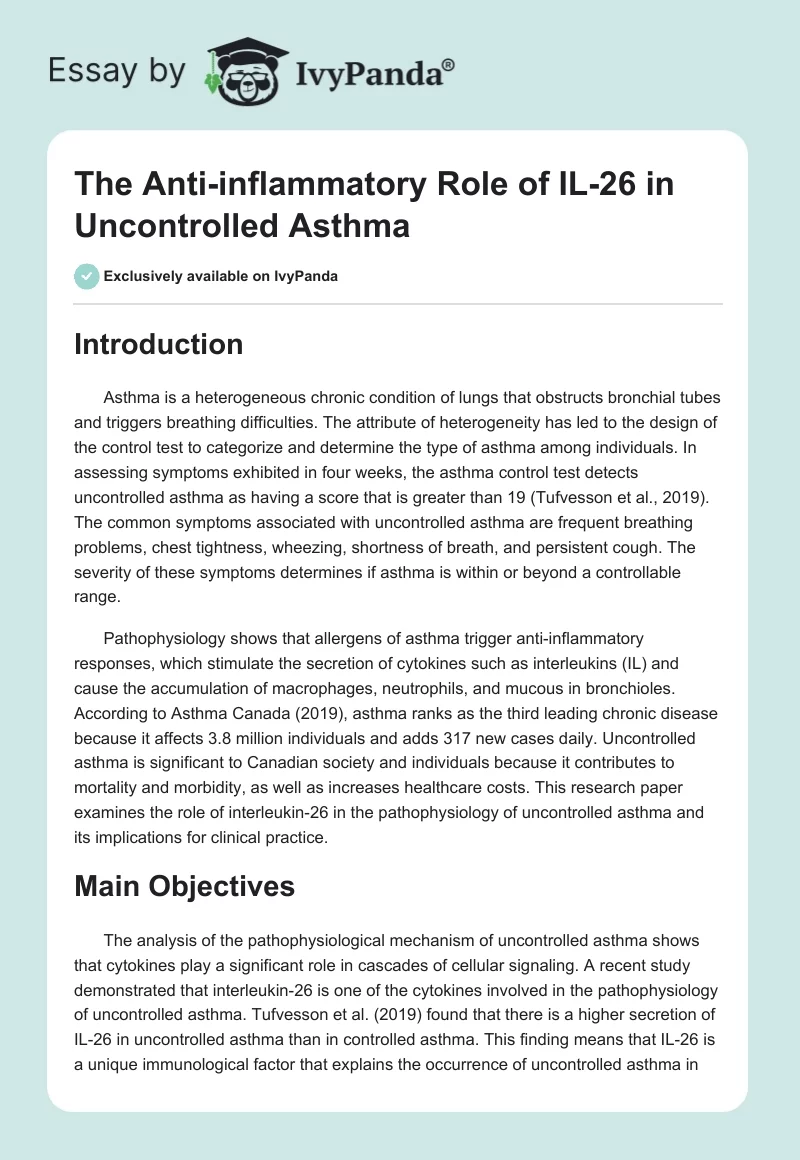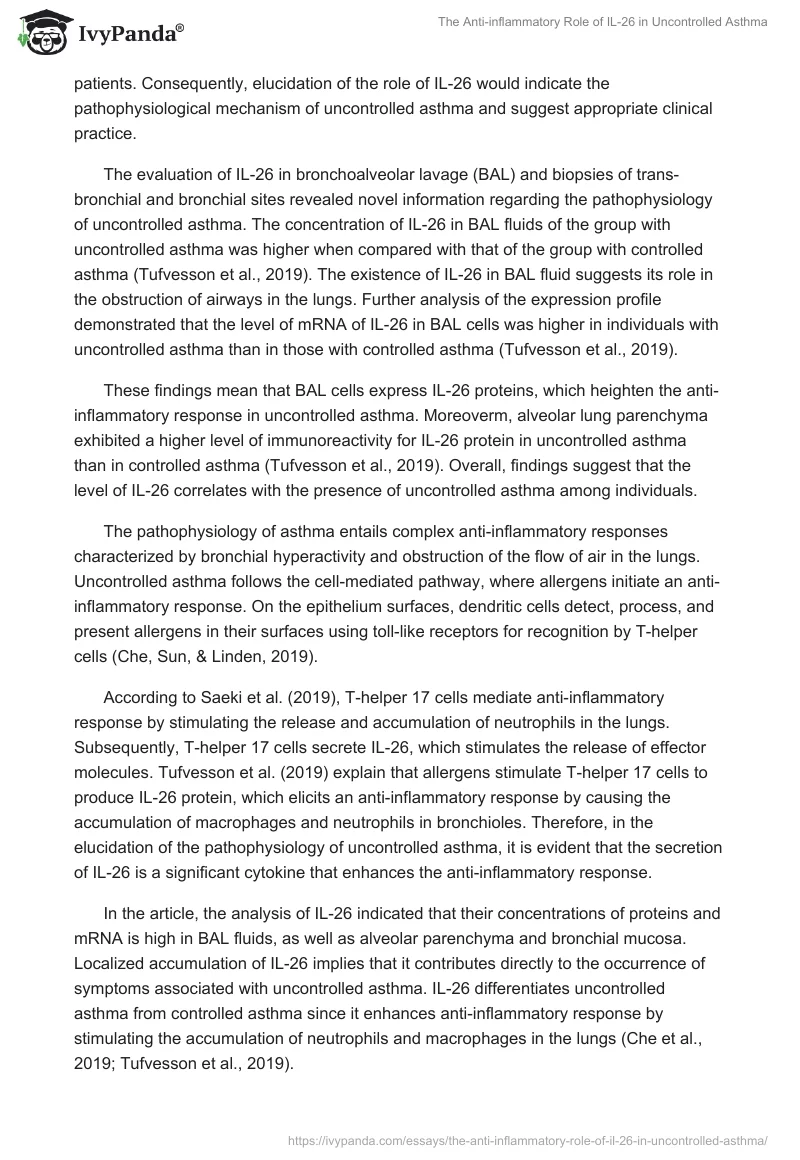Introduction
Asthma is a heterogeneous chronic condition of lungs that obstructs bronchial tubes and triggers breathing difficulties. The attribute of heterogeneity has led to the design of the control test to categorize and determine the type of asthma among individuals. In assessing symptoms exhibited in four weeks, the asthma control test detects uncontrolled asthma as having a score that is greater than 19 (Tufvesson et al., 2019). The common symptoms associated with uncontrolled asthma are frequent breathing problems, chest tightness, wheezing, shortness of breath, and persistent cough. The severity of these symptoms determines if asthma is within or beyond a controllable range.
Pathophysiology shows that allergens of asthma trigger anti-inflammatory responses, which stimulate the secretion of cytokines such as interleukins (IL) and cause the accumulation of macrophages, neutrophils, and mucous in bronchioles. According to Asthma Canada (2019), asthma ranks as the third leading chronic disease because it affects 3.8 million individuals and adds 317 new cases daily. Uncontrolled asthma is significant to Canadian society and individuals because it contributes to mortality and morbidity, as well as increases healthcare costs. This research paper examines the role of interleukin-26 in the pathophysiology of uncontrolled asthma and its implications for clinical practice.
Main Objectives
The analysis of the pathophysiological mechanism of uncontrolled asthma shows that cytokines play a significant role in cascades of cellular signaling. A recent study demonstrated that interleukin-26 is one of the cytokines involved in the pathophysiology of uncontrolled asthma. Tufvesson et al. (2019) found that there is a higher secretion of IL-26 in uncontrolled asthma than in controlled asthma. This finding means that IL-26 is a unique immunological factor that explains the occurrence of uncontrolled asthma in patients. Consequently, elucidation of the role of IL-26 would indicate the pathophysiological mechanism of uncontrolled asthma and suggest appropriate clinical practice.
The evaluation of IL-26 in bronchoalveolar lavage (BAL) and biopsies of trans-bronchial and bronchial sites revealed novel information regarding the pathophysiology of uncontrolled asthma. The concentration of IL-26 in BAL fluids of the group with uncontrolled asthma was higher when compared with that of the group with controlled asthma (Tufvesson et al., 2019). The existence of IL-26 in BAL fluid suggests its role in the obstruction of airways in the lungs. Further analysis of the expression profile demonstrated that the level of mRNA of IL-26 in BAL cells was higher in individuals with uncontrolled asthma than in those with controlled asthma (Tufvesson et al., 2019).
These findings mean that BAL cells express IL-26 proteins, which heighten the anti-inflammatory response in uncontrolled asthma. Moreoverm, alveolar lung parenchyma exhibited a higher level of immunoreactivity for IL-26 protein in uncontrolled asthma than in controlled asthma (Tufvesson et al., 2019). Overall, findings suggest that the level of IL-26 correlates with the presence of uncontrolled asthma among individuals.
The pathophysiology of asthma entails complex anti-inflammatory responses characterized by bronchial hyperactivity and obstruction of the flow of air in the lungs. Uncontrolled asthma follows the cell-mediated pathway, where allergens initiate an anti-inflammatory response. On the epithelium surfaces, dendritic cells detect, process, and present allergens in their surfaces using toll-like receptors for recognition by T-helper cells (Che, Sun, & Linden, 2019).
According to Saeki et al. (2019), T-helper 17 cells mediate anti-inflammatory response by stimulating the release and accumulation of neutrophils in the lungs. Subsequently, T-helper 17 cells secrete IL-26, which stimulates the release of effector molecules. Tufvesson et al. (2019) explain that allergens stimulate T-helper 17 cells to produce IL-26 protein, which elicits an anti-inflammatory response by causing the accumulation of macrophages and neutrophils in bronchioles. Therefore, in the elucidation of the pathophysiology of uncontrolled asthma, it is evident that the secretion of IL-26 is a significant cytokine that enhances the anti-inflammatory response.
In the article, the analysis of IL-26 indicated that their concentrations of proteins and mRNA is high in BAL fluids, as well as alveolar parenchyma and bronchial mucosa. Localized accumulation of IL-26 implies that it contributes directly to the occurrence of symptoms associated with uncontrolled asthma. IL-26 differentiates uncontrolled asthma from controlled asthma since it enhances anti-inflammatory response by stimulating the accumulation of neutrophils and macrophages in the lungs (Che et al., 2019; Tufvesson et al., 2019).
In a recent study, Che et al. (2019) revealed that lung fibroblasts undertake constitutive secretion of IL-26 following endotoxin-induced stimulation. Subsequently, IL-26 stimulates the release of other neutrophil-mobilizing cytokines and amplify the anti-inflammatory response. Che et al. (2019) report that the concentration of IL-26 increases with the IL-8 and IL-8 and causes the phosphorylation of kinases in the pathways of intracellular signaling molecules, such as p38, NF-κB, and JNK, and ERK. Hence, IL-26 works in conjunction with other cytokines and kinases in mounting a robust anti-inflammatory response.
Conclusion
The discovery of the role of IL-26 in the pathophysiology of uncontrolled asthma has considerable influence on clinical practice. Research findings suggest that the suppression of IL-26 secretion in the lungs would alleviate the anti-inflammatory response associated with uncontrolled asthma. The implication is that novel drugs used in the treatment of asthma targets to alleviate the production of IL-26 by lung fibroblasts. Recent studies have shown that hydrocortisone, glucocorticoid, and corticosteroids have inhibitory effects on the release of IL-26, IL-8, and IL-6, and subsequently decrease the phosphorylation state of intracellular kinases (O’Byrne et al., 2019; Che et al., 2019). Therefore, clinical practice should consider using IL-26 as a molecular marker of uncontrolled asthma, as well as targets its inhibition in treatment.
References
Asthma Canada. (2019). Asthma facts and statistics. Web.
Che, K. F., Sun, J., & Linden, A. (2019). Pharmacological modulation of endotoxin-induced release of il-26 in human primary lung fibroblasts. Frontiers in Pharmacology, 10, 1-12. Web.
O’Byrne, P., Fabbri, L. M., Pavord, I. D., Papi, A., Petruzzelli, S., & Lange, P. (2019). Asthma progression and mortality: The role of inhaled corticosteroids. The European Respiratory Journal, 54(1), 1-14. Web.
Saeki, M., Nishimura, T., Kitamura, N., Hiroi, T., Mori, A., & Kaminuma, O. (2019). Potential mechanisms of T cell-mediated and eosinophil-independent bronchial hyperresponsiveness. International Journal of Molecular Sciences, 20(12), 1-16. Web.
Tufvesson, E., Jogdand, P., Che, K., Levanen, B., Erjefalt, J., Linder, L., & Linden, A. (2019). Enhanced local production of IL-26 in uncontrolled compared with controlled adult asthma. The Journal of Allergy and Clinical Immunology, 144(4), 1134-1136. Web.


